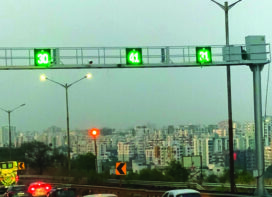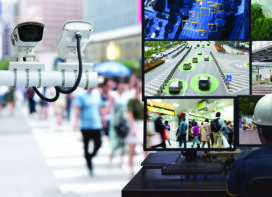 India has more congested cities than any other nation, which is not surprising given the fact that it is also the world’s second-most populous country, after China. Add to this the information that there has been a staggering 100-fold increase in the number of motorised vehicles in India while the expansion in the road network has not been commensurate with this increase and you get a recipe for disaster.
India has more congested cities than any other nation, which is not surprising given the fact that it is also the world’s second-most populous country, after China. Add to this the information that there has been a staggering 100-fold increase in the number of motorised vehicles in India while the expansion in the road network has not been commensurate with this increase and you get a recipe for disaster.
A normal situation of traffic in countries includes automobiles, buses, trucks, trains, motorcycles, motor scooters and bicycles. But in India, an acute network of auto-rickshaws and two-wheelers along with children running around or playing cricket or even sleeping on the roads, add substantially to the congestion. Adding to this mayhem are bullock carts and hand-pulled rickshaws. The Indian cities need to plan not only for increasing the road network but also providing efficient and adequate parking facilities to meet this exploding number of modes of transport. Adequate space allotment by the local authorities and proper utilisation of parking facilities are the broad based solutions. However, application of modern technology using advanced parking revenue management systems, availability of centralised information and controls and user-friendly guidance on strategies of available parking facilities can address the parking woes more effectively. Technology must also provide convenient payment mechanisms to empower the person parking.
around or playing cricket or even sleeping on the roads, add substantially to the congestion. Adding to this mayhem are bullock carts and hand-pulled rickshaws. The Indian cities need to plan not only for increasing the road network but also providing efficient and adequate parking facilities to meet this exploding number of modes of transport. Adequate space allotment by the local authorities and proper utilisation of parking facilities are the broad based solutions. However, application of modern technology using advanced parking revenue management systems, availability of centralised information and controls and user-friendly guidance on strategies of available parking facilities can address the parking woes more effectively. Technology must also provide convenient payment mechanisms to empower the person parking.
What is needed in a city
It is important to have an integrated transport system where parking space can be found quickly and easily, people can switch on a large scale to public transport and need to pay only once – whichever mode of travel they use. This will ease the commuting problems of citizens. And for this, all parking facilities need to be combined in a network and connected with the municipal traffic management system. That would actually mean a centralised control and monitoring of all systems. And that, in turn, would lead to unimpeded traffic flow and a safer environment.
It is also important to provide the citizens with service-oriented offers such as Park & Ride, common payment models for parking and city tolls, or cards that connect the city. With the usage of right technology, the citizens will be one step ahead when it comes to a hassle-free city experience.
Parking and traffic management principles
These ten general principles must be kept in mind to support parking decisions and management:
1. Consumer choice: People should have viable parking and travel options.
2. User information: Motorists should have information on their parking and travel options.
3. Sharing: Parking facilities should serve multiple users and destinations.
4. Efficient utilisation: Parking facilities should be sized and managed well, so spaces are frequently occupied.
5. Flexibility: Parking plans should accommodate uncertainty and change.
6. Prioritisation: The most desirable spaces should be managed to favour high-priority users.
7. Pricing: As much as possible, charges should be dynamic.
8. Peak management: Special efforts should be made to deal with peak-demand.
9. Quality vs. quantity: The quality of parking facility should be considered as important as quantity. Aesthetics, security, accessibility and user information must be given due importance.
10. Comprehensive analysis: All significant costs and benefits should be considered while planning the parking system.
Parking Formats
On-street parking
This is a key factor in promoting businesses in cities, particularly within central business districts. As a type of shared parking, on-street parking is an efficient way of allowing multiple users to reach multiple destinations. On-street parking utilises less land per space than off-street parking and provides easy access to businesses located on a city’s streets. For pedestrians, on-street parking creates a buffer between moving traffic and individuals walking on the sidewalks, thereby providing a measure of safety and reducing the level of perceived noise.
Pay and display hand held terminals can be used at busy commercial areas, outside cinema halls, residential buildings on streets, outside stadiums etc.
The on-street parking spaces can be effectively optimised by improving the road surface and providing suitable markings and kerb linings.
Off-street parking
The open spaces shall be developed on the available ground spaces away from the arterial road network. The spaces should be created out of concrete or paved block or asphalt surfaces with proper markings and fence lines.
Off Street Parking is parking of vehicles in a convenient and protected area controlled by automated entry and exit barrier gates. Parking can be done either in vacant space outside or within building basements. User comes to the entry gate and flashes the smart card. Once the card is shown and validated, the barrier gate opens automatically for the entry into the parking lot deducting full value from the card. At the exit, the card is validated and credited with the balance. Once the transaction is complete, the exit barrier opens for exit. For casual parker, the same system can be managed by an attendant and cashier.
Advantages
• Quick and effortless parking for pick up and drop off
• Pay only for the time duration parked
• Safety and security for vehicles and passengers
• Automated payment mechanisms
Multilevel Parking
The areas in cities that are the most congested in terms of traffic must be de-congested by creating multi-level parking facilities. These must be appropriately located, easily accessible and well marked. Such parking infrastructure must spread throughout the city. The goal is to minimise parking in usable areas of streets, thereby allowing the street to be used for free flow of traffic and at the same time providing the commuter with easy access to convenient parking. The same must be designed and constructed aesthetically to depict the local architecture.
A comprehensive parking management system
A large number of software configurable functions make this system a powerful tool. The system maintains control of all devices, keeping the relevant party abreast of the complete parking status and activities. Ease of remote configuration and customer management has never been easier. Intelligent reporting keeps the controlling authorities completely in tune with flow, peak traffic periods, usage patterns and areas of high and low traffic concentration. Provision must be made for booking parking spaces online and add-on facilities can be given to regular customers. The Park and Ride concept has also caught on the world over. The system allows for use of multiple data carriers and has the flexibility to integrate with other third party cards.
Advantages
• A comprehensive parking management system
• Intuitive networking capabilities
• Numerous parking facilities in one city
• Maximum utilisation based on connection to municipal traffic management systems
• High efficiency through centralised control of networked parking garages
• Intelligent remote monitoring and proactive service management with Operator Services
• Business intelligence via centralised data management
• Integration of third-party solutions based on open systems such as city cards
• Individual parking space monitoring and license plate recognition
• Connectivity, Mobility and Management – because just parking is a thing of the past
 Nimish Sonawala
Managing Director (SAARC)
SKIDATA (India) Pvt Ltd
Nimish Sonawala
Managing Director (SAARC)
SKIDATA (India) Pvt Ltd
 TrafficInfraTech Magazine Linking People Places & Progress
TrafficInfraTech Magazine Linking People Places & Progress


